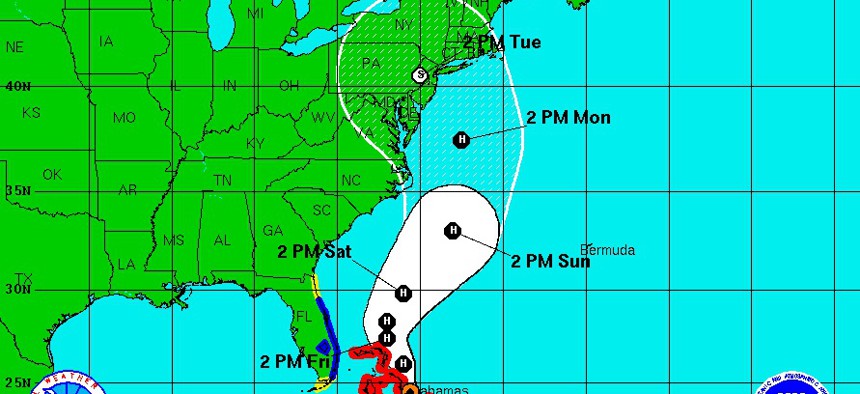
NOAA
Hurricane Sandy Threatens East Coast—How to Prepare
FEMA has issued guidance to make sure you're prepared for a direct hit.
Before I wrote the Promising Practices blog here at Government Executive, I worked with the federal government on emergency preparedness issues. So when FEMA sends guidance on how you can prepare for a potentially hazardous situation, I tend to listen—and feel obligated to pass that advice along.
Forecasts from the National Hurricane Center and the National Weather Service say Hurricane Sandy will bring intensifying winds over Florida and spread north to the Outer Banks of North Carolina and Virginia Beach through Saturday.
As we saw last year with Hurricane Irene, the East Coast isn’t immune to hurricanes (or earthquakes, we're finding). Experts say one of three scenarios may play out with Hurricane Sandy—it misses the eastern seaboard entirely, brushes by or slams directly into the region early next week (happy Halloween!).
“A direct-hit scenario would have ‘huge implications’ in New England," FEMA said in a statement. "Even if Sandy only makes a ‘close pass’ it will likely be impactful to the New England region with strong winds that would topple trees causing widespread power outages, storm surge, and coastal flooding.”
FEMA advises the following:
If you have not done so already, it is important to ensure you:
- Check your family’s emergency supply kit – make certain you have food, water, medications, and other necessities to sustain you, your family and family pets for at least 72 hours.
- Follow the direction of local officials –evacuation orders may be issued by officials, so follow their guidance. When it comes to swimming, follow local warnings as well. Even the best swimmers can fall victim to the strong waves and rip currents caused by storms.
- Keep up to date with local conditions – follow TV and radio reports from your area, or visit www.weather.gov (http://mobile.weather.gov on your phone) for the latest forecast.
- Remember food safety – power outages and flooding may happen as a result of a tropical storm or hurricane, so have a plan for keeping food safe. Have a cooler on hand to keep food cold, and group food together in the freezer so it stays cold longer.
- Have an adequate communication plan - be sure friends and family know how to contact you. Teach family members how to use text messaging as text messages can often get around network disruptions when a phone call can’t get through.
Hurricane Smartphone Apps:
- FEMA App – Android, Apple, Blackberry
- American Red Cross “Hurricane” app – Android, Apple
Latest Sandy information and forecasts from the National Hurricane Center
- On your computer: www.Ready.gov/hurricanes or www.hurricanes.gov
- On your phone: m.fema.gov , FEMA app or http://hurricanes.gov/mobile
- On Twitter: www.twitter.com/NHC_Atlantic
- On Facebook: www.facebook.com/US.NOAA.NationalHurricaneCenter.gov
Community preparedness tools and resources
- Community Preparedness Toolkit: http://www.citizencorps.gov/getstarted/toolkit/kitindex.shtm
- Citizen Corps Program: http://www.citizencorps.gov/index.shtm
- Youth Preparedness: http://www.citizencorps.gov/getstarted/youth/youthindex.shtm
- Business Preparedness: http://www.citizencorps.gov/getstarted/business.shtm
- Neighbors Helping Neighbors: http://www.citizencorps.gov/getstarted/neighborshelpingneighbors.shtm
Do you have any advice on Hurricane preparedness worth sharing?







